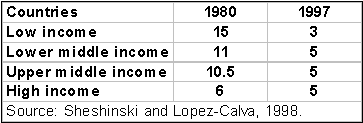|
Proceedings Presentation
of Country Reports Country: Chile
The
Chilean Experience with Privatization by Guillermo Pattillo
Universidad
de Santiago de Chile Contents (Powerpoint
presentation) 1. The
expected outcomes from privatization. 2. Privatization
trends at a global level. 3. General
guidelines for successful privatization. 4. The
Chilean experience. 1.
The expected outcomes Why to privatize? In
general because SOEs have proved to be inefficient, then reducing social
welfare. The
attempts through the 1970s and 80s to reform SOEs by imposing hard budget
constraints, exposing them to competition and introducing institutional
changes produced meager results.
The effects of
privatization can be grouped
into five categories: a)
Firms performance, in general the evidence shows that privatization improves
performance. b)
Fiscal balance and growth, privatization has fiscal benefits and is
highly correlated with growth. c)
Welfare, effects have
been positive. d)
Employment, when correctly measured privatization has led
to employment increases at both the firm and the industry level. e)
Income and wealth distribution, no clear answer so
far (this is the least studied aspect of privatization).
2.
The global trends In the last decade a
clear upward trend can be observed, both in terms of numbers and value of
transactions. In
1990 global proceeds reached US$ 30 billion; in 1999 US$ 145 billion. Total
global proceeds of the period: US$ 850 billion. Developing countries
(where privatization is a growing activity) account for something close to
US$ 250 billion in that period. In
regional terms, Latin America accounted for a large share of non-OECD
privatization process. Foreign participation in this process has been increasing over the years, in Latin America, Eastern Europe and East Asia. Change
in SOEs Activity as Percentage of GDP
3.
General guidelines Commitment and
ownership, privatization requires strong political
commitment and an informed society. Ownership and
competition, ownership change is needed to make competition
effective. Transparency,
without transparency the acceptance of privatization is severely reduced. Mitigating the social
short-run possible impacts of privatization, in some cases
workforce reductions will be necessary so a system to compensate for
layoffs must be in place. Environmental
implications, in general SOEs pollute more than private
firms. Privatization can be an opportunity for environmental improvements. 4.
The Chilean case The Chilean
privatization process was one of the earliest in the current global move to
privatize. Privatization
was part of a much wider process of economic liberalization that the country
initiated in 1974. Chile
has had three major rounds of privatization: 1974-1980, 1984-1989 and since
1990. In the first phase 259
firms that were expropriated or illegally taken during the Allende’s
government were restored to their original owners. Also 118 firms were sold
or liquidated and 34 (of 65) pre-1970 SOEs were privatized or closed. At
the end of the decade there were 40 SOEs. The
second phase was the time for telecom, electricity and steel production. Since 1990 the privatization process slowed down
significantly. Nevertheless, the driving force was the privatization of the
main water and sewage companies (3) and of infrastructure management. Today
the process is unfinished. Still 38 firms, that represent around 9% of GDP,
are SOEs. Chile:
Evolution of SOEs (number of firms)
SOEs relevance in sectorial GDP
A
general conclusion today (and one with which there is consensus) is that
SOEs increased their profitability and efficiency after privatization. But,
the productivity of firms (private since the 80s) that provide regulated
services has increased by more than in the case of non-regulated firms.
Other
privatization are:
Performance of privatized firms The
results refers to 37 non-financial firms, 19 of which works in regulated
sectors. The
variables under analysis were profitability, efficiency, productivity and
employment. As
a general conclusion, it can be asserted that the evolution in all these
areas has been positive. Changes in profitability
|







